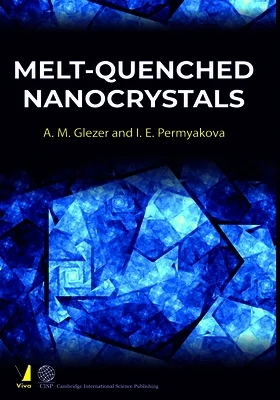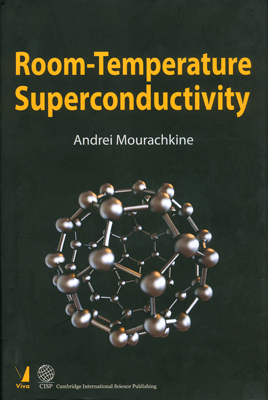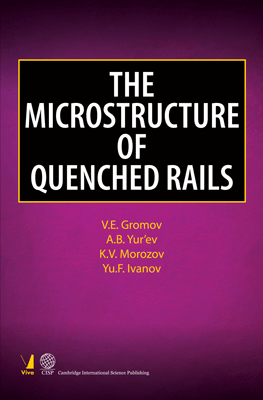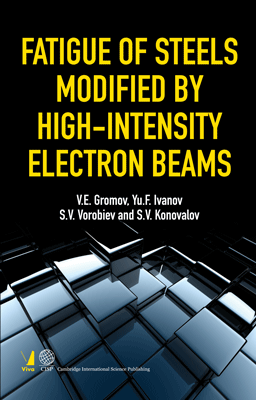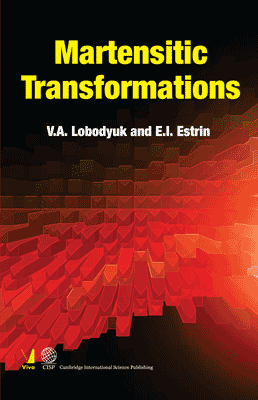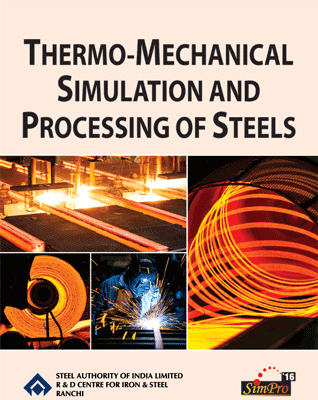Materials Science and Engineering
Materials Science and Engineering
₹1,075.50 ₹1,195.00 Save: ₹119.50 (10%)
Go to cartISBN: 9788130924830
Bind: Paperback
Year: 2020
Pages: 704
Size: 172 x 242 mm
Publisher: Viva Books Originals
Sales Territory: Worldwide
Description:
First of its kind, this book describes structure-property-processing-performance relationships in varied classes of materials: metals, ceramics, polymers and composites. Some additional features of the book are:
- Serves as textbook for engineering students and also as a handbook for practising engineering
- More quantitative and design-oriented treatment
- Well-illustrated with worked examples dealing with engineering aspects of materials
- Abundant questions and problems at the end of each chapter
- All chapters interwoven in a style so that students from various engineering disciplines achieve real appreciation for materials
- Numerous case studies of different levels
Target Audience:
Undergraduate students in all engineering colleges, practising engineers in manufacturing industries.
Contents:
Chapter 1 - Introduction • Engineering Materials Classification • Metals • Ceramics • Polymers • Composites • Advanced Materials • Chapter 1 - Bonding and Structure of Materials • Bonding in Solids • Metallic Bond • Ionic Bond • Covalent Bond • Van der Waals Bond • Mixed Bond • Forces between Atoms/Molecules • Crystal Systems • Packing in Crystals • Voids in Unit Cells • Interplaner Spacings • Crystal Structure of Carbon • Crystal Structures of Inorganic Compounds • AX type Compounds • AmXp type Compounds • AmBnXp type Compounds • Silicates • Structure of Glasses • Structure of Polymers • Structure of Polymer Chain • Defect Structures in Crystals • Point Defects • Line Defects • Surface Defects • Bulk or Volume Defects • Microstructures • Macrostructures • Questions and Problems • Chapter 3 - Phase Equilibria and Transformation • The Phase Rule • Unary Phase Diagram • Binary Phase Diagrams • Isomorphous System • Eutectic and Eutectoid Systems • Peritectic and Peritectoid Systems • Other Binary reactions • Iron-Carbon Phase Diagram • Ternary Systems • Calculated Phase Diagrams • Hume-Rothery Rules for Alloy Formation • Diffusion in Solids • Phase Transformation • Transformation Kinetics • Homogeneous Phase Transformation • Heat Treatment of Steels • Hardenability • Various Heat Treatment Operations • Case Carburising and Carbonitriding • Precipitation and Precipitation Hardening • Effect of Annealing on Cold Worked Metals • Phase Transition in Glasses • Annealing of Glasses • Questions and Problems • Chapter 4 - Physical Properties of Materials • Electronic Energy levels in Solids • Electrical Properties • Electrical Properties of Conductors • Electrical properties of Semiconductors • Electrical properties of Insulators • Ferroelectricity • Piezoelectricity • Related Electrical Phenomena in Materials • Electron Emission • Thermoelectricity • Magnetic Properties • Classification of Materials according to Magnetic Properties • Ferromagnetic Domain and Magnetization Curve • Soft and Hard Magnetic Materials • Ferrimagnetic Materials • Magnetic Storage • Superconductivity • Thermal Conductivity • Thermal Expansion • Thermal Shock Resistance • Optical properties • Refractive Index • Questions and Problems • Chapter 5 - Mechanical Properties of Materials • Theoretical Strength of Crystalline Materials • Plasticity and Role of Dislocation • Critical Resolved Shear Stress • Stress-Strain Behaviour • True Stress True Strain • Strain Ageing • Effect of Strain Rate • Tensile Properties of Two Phase Alloys • Tensile Behaviour of Ceramics and Polymers • Behaviour under Compression • Behaviour under Bending • Behaviour under Shear and Torsion • Bauschinger Effect • Hardness • Brinell Hardness Test • Vickers Hardness Test • Rockwell Hardness Test • Micro-hardness Test • Hot Torsion Test • Impact Toughness • Ductile-Brittle Transition • Notch-Toughness of Polymers • Fatigue • Estimation of S-N Curves • Cumulative Fatigue Damage • Factors Affecting Fatigue Life • Creep • Mechanism of Creep Deformation and Rupture • Creep in Polymers • Creep Life Estimation • Fracture and Fracture Toughness • Crack Tips in Real Materials • Fracture Toughness • Fracture Toughness and Fatigue Life • Statistics of Brittle Fracture • Strengthening Mechanisms • Combined Strengthening Mechanisms • Toughening in Ceramics and Composites • Questions and Problems • Chapter 6 - Electrochemical Properties, Corrosion and Degradation • Electrochemical and Galvanic Cells • Standard Elecdrode Potentials • Polarization • Passivity • Potential-pH Diagrams • Inhibitors • Cathodic Protection • Types of Corrosion and their Prevention • Uniform Corrosion (oxidation) • Galvanic Corrosion • Crevice and Pitting Corrosion • Environmentally Induced Cracking • Hydrogen damage • Intergranular Corrosion • Dealloying • Erosion Corrosion and Fretting • Bio Corrosion • Corrosion Rate Units • High temperature Oxidation • Thermodynamics of Oxidation • Kinetics of Oxidation • Mechanism of Oxidation • Combined Oxidation-Sulphidation of Metals • Design against Corrosion • Batteries • Corrosion of Ceramics and Glasses • Degradation of Polymers • Questions and Problems • Chapter 7 - Engineering Materials • Metallic and Intermetallic Materials • Ferrous Alloys • High Strength Low Alloy (HSLA) Steels • Medium and High alloy Steels • Cast Irons • Copper Alloys • Brasses • Bronzes • Cupronickels • Aluminium Alloys • Magnesium Alloys • Nickel Alloys • Titanium Alloys • Precious Metals • Refractory Metals and their based Alloys • Intermetallics • Ceramic Materials • Refractories • Pure Oxide Ceramics • Magnetic Oxides • Ferroelectric Oxides • Oxide Superconductors • Nonoxide Ceramics • Refractory Compounds • Silicon Carbide • Silicon Nitride • Boron Carbide • Boron Nitride • Aluminium Nitride • Glasses • Polymeric Materials • Thermoplastic Polymers • ABS, SAN • Acetals • Acrylics • Flurocarbons • Polyamides • Polycarbonates • Thermosetting Polymers • Aminos • Epoxides • Phenolics • Natural Polymers • Composite Materials • Metal Matrix Composites • Ceramic Matrix Composites • Polymer Matrix Composites • Nanomaterials • Questions and Problems • Chapter 8 - Materials Forming • Solidification Forming • Scientific Basics of Metal Casting • Structural Evolution • Heat Transfer • Melt Flow • Stress Behaviour • Ingot and Continuous Casting • Single Crystal Growing and Zone Refining • Metal Casting Technology • Sand Casting • Shell-Mould Casting • Expanded Polystyrene Process • Investment Casting • Permanent Mould Casting • Die Casting • Centrifugal Casting • Squeeze Casting • Semi-Solid Solidification Processing • Polymer Solidification Forming • Injection Moulding • Extrusion • Forming of Polymer Matrix Composites • Glass Solidification Processing • Deformation Forming • Plastic Yielding and Deformation Processing • Forging • Rolling • Extrusion • Bar and Wire Drawing • Deep Drawing of Metal Sheet • Stretch Forming • Formability or Workability of Metals and Alloys • Metallurgical Factors Influencing Workability • Thermomechanical Forming • Super-Plastic Forming • Thermoforming of Polymers • Process Design in Deformation Processing • Powder Metallurgy Forming • Metal Powder Production and Treatment • Ceramic Powder Production • Metal/Ceramic Powder Characterization • Powder Compaction • Sintering and Post-Sintering Treatment • Hot Consolidation of Powders • Spray Forming • Powder Injection Moulding • Solid Freeform Fabrication • Questions and Problems • Chapter 9 - Materials Removal • Machining • Conventional Metal Cutting • The Cutting Tool • Chip Formation during Machining • Cutting Tool Materials • Cutting Fluids • Cutting Tool Wear • Machinability • Grinding • Non-Conventional Machining • Design Aspects in Machining • Economics of Machining • Friction and Wear • Design against Wear • Questions and Problems • Chapter10 - Materials Joining • Welding Processes • Gas Welding • Arc Welding • Electroslag Welding • Resistance Welding • Thermit Welding • Solid State Welding • Weldability of Metals and Alloys • Weldability of Carbon and Low Alloy Steels • Weldability of High Alloy Steels • Weldability of Cast Irons • Weldabilty of Nonferrous Metals and Alloys • Weldment Cracking and Porosity • Weld Design • Brazing and Soldering • Transient Liquid Phase Bonding • Adhesive Bonding • Ceramic-Ceramic; Ceramic-Metal Bonding • Joining of Polymers • Joining of Sintered Metals and Alloys • Questions and Problems • Chapter 11 - Surface Modification • Mechanical Treatment • Thermal Treatment • Thermochemical Treatments • Electro and Electroless Plating • Vapour Deposition Processes • Molten State Deposition • Porcelain Enameling/Ceramic Coating • Economics of Various Surface Technologies • Case Study: Piston Ring • Questions and Problems • Chapter 12 - Materials Design • Introduction • Materials Selection Charts and Performance Index • Materials Design for Structural Applications • Room and Low Temparature Service • Case Study: Materials for Fuel efficient Automobiles • Case Study: High Strength Steels for Automobiles • Case Study: Rail Steels • Case Study: Enhanced Properties of Steels through Novel Heat Treatments • Case Study: Cryogenic Storage Container • Case Study: Design against Fatigue of Welded Structures • Case Study: Sintered Camshaft Pulley • Case Study: Fatigue in Transmission Gear • Case Study: Fatigue in P/M Connecting Rod • Case Study: Austempered Ductile Iron • Case Study: Steel Framed Building and Houses • Case Study: Superplastic Metallic Alloys • Case Study: Cost Effective Substitute for Bronze Bearings • Elevated Temperature Service • Case Study: Concrete-filled Hollow Steel Sections • Case Study: Ceramic Liner for Piston Engines • Case Study: Ceramic Glow Plug • Case Study: Microstructural Engineering of Silicon Nitride • Case Study: Comparative Assessmemt of Silicon Nitride and Silicon Carbide • Case Study: Metal Matrix Composites: P/M Al-SiC in particular • Multi Constraint Service • Case Study: Wear Aspects in Petrol Engine • Case Study: Boiler Tubing Steels for Fossil Fuel Power Plants • Case Study: Future Fossil Fuel Plant Materials • Case Study: Alloy Cast Iron Brake Drums • Case Study: Heat Resistant Materials for Oil Refineries and Petro-chemical Plants • Case Study: Materials for Gas Scrubbing Devices • Case Study: High Duty Mechanical Seals • Materials Design for Tools • Case Study: Conventional and P/M High Speed Steels • Case Study: Cermets using Spinodal Transformation • Case Study: Diamond Tools for Stone Sawing • Materials Design for Electrical Applications • Case Study: Conductors at Elevated Temperatures • Case Study: Magnet Conductor Wires • Case Study: Electrical Contact Materials • Case Study: Ceramic Resistors for High Temperature Heating • Case Study: Capacitors in Electronic Industries • Materials Design for Magnetic Applications • Case Study: Oriented Fe-Si Alloy Sheets • Case Study: Nd-Fe-B Permanent Magnets • Case Study: Magnetic Oxide Powders for Tapes and Discs • Case Study: Processing of Y-Ba-Cu-O based High Tc Superconductors • Materials Design for Devices • Case Study: Semiconductor Device and its Metallization • Case Study: Glass-to-Metal Seal and Heat Sinks • Case Study: Piezoelectric Transducers • Case Study: Shape Memory Alloy Devices • Case Study: Solid Oxide Fuel Cells • Case Study: Fibre-Optic Cables • Materials Processing Selection • Materials Design/ Product Design Relationships • CAD/CAM Systems • Questions and Problems • Answers to Problems • Index
About the Authors:
Prof. G. S. Upadhyaya is an internationally renowned materials engineer and has a teaching and research experience of more than four decades in India and abroad. He has guided several engineering students and at present is busy as materials consultant. He has received numerous national and international awards, including G. D. Birla Award from the Indian Institute of Metals and Niobium medal from the Max Planck Institute, Germany. Dr. Upadhyaya has published over 350 articles and has authored 12 books.
Dr. Anish Upadhyaya is Assistant Professor in Materials and Metallurgical Engineering Department at the Indian Institute of Technology, Kanpur. He did his B.Tech. in Metallurgical Engineering from the Institute of Technology, BHU and Masters and Ph.D. From the Pennsylvania State University. Before joining IIT Kanpur, he worked at Penn State as Research Associate and in WIDIA, Bangalore, as Manager, R&D. His research specialization is powder metallurgy processing of materials and he has over 60 publications in various national and international journals and conference proceedings. He is the recipient of a number of awards for his contributions in the field of Materials Engineering. In addition, he is a consultant for numerous manufacturing companies.

